| 1Ø | Single phase electric power |
| 3Ø | Three phase electric power |
| 38-02 | The most recent ASCE guidelines for the depiction of buried utilities (SUE). Usually referred to as ASCE 38-02. |
| 50-cycle | The frequency of electric power (50 hertz) generated in Europe, Africa, Asia, and most of the world, including Mexico and most of Central America. |
| 60-cycle | The frequency of electric power (60 hertz) generated In the United States, Canada, and South America. |
| 811 | The three digit phone number for being connected to the One Call system in the area where you are working. |
A
| A-B | A-B Cables: Transcontinental communication cables installed in 1942. These are recognizable by wooden posts with pre-stamped metal markers. |
| ABS | Acrylonitrile-Butadiene-Styrene: Plastic piping material typically used for heavy industrial use. |
| AC | Asbestos Cement: Pipe made from cement and asbestos. |
| AC | Alternating Current: Current that alters its direction at a given frequency. All electric power is delivered to the subscriber/customer as AC. |
| ACP | Asbestos Cement Pipe: Same as AC |
| ACSR | Aluminum Conductor Steel Reinforced – The standard aerial power cables of today, found on power pole lines around the world. |
| AEC | Architecture – Engineering – Construction | An acronym used to represent the entire “hardhat” industry, including the Utility industry. |
| AML | All Materials Locator: Utility locating device manufactured by Subsurface Instruments Inc. Uses ultra-high radio frequencies to detect the smooth-sided surface of buried utilities, specifically pipes. |
| AMP | Amplifier: A common feature on coaxial Cable TV to boost the voltage. Can be ground-mounted or aerial. |
| AMPP | Association for Materials Protection and Performance: A new international organization dealing with pipeline integrity and corrosion, including cathodic protection systems. NACE is now a part of the AMPP. |
| AMR | Automatic Meter Reader: A small rubber encased electronic device that transmits a Bluetooth signal which can be read by a specially equipped truck passing down the street. Used for remote reading of water meters. |
| AOC | Adverse Operating Conditions; A reference to any condition in the gas/petroleum industry when equipment is not functioning properly. |
| AP | Access Pedestal or Access Point: A large telephone pedestal, typically with only cables but no services. Can be opened very wide for easy access inside. |
| ARV | Air Release Valve in pressurized water systems. |
| ASCE | American Society of Civil Engineers |
| ASW | Aerial Service Wire: Aerial Single-Pair Phone service with a rigid outer sheath. See RSW. |
| AT | Aerial Tape: Armored aerial telephone cable. Shown on the phone prints following the 4-letter code, such as: BKTA-AT. |
| ATMS | Automated Traffic Management System: Statewide traffic system, which uses VMS boards, cameras, and other features. Some State DOTs refer to this as TMS, while a few of them call it Intelligent Traffic System (ITS). |
| AWG | American Wire Gauge |
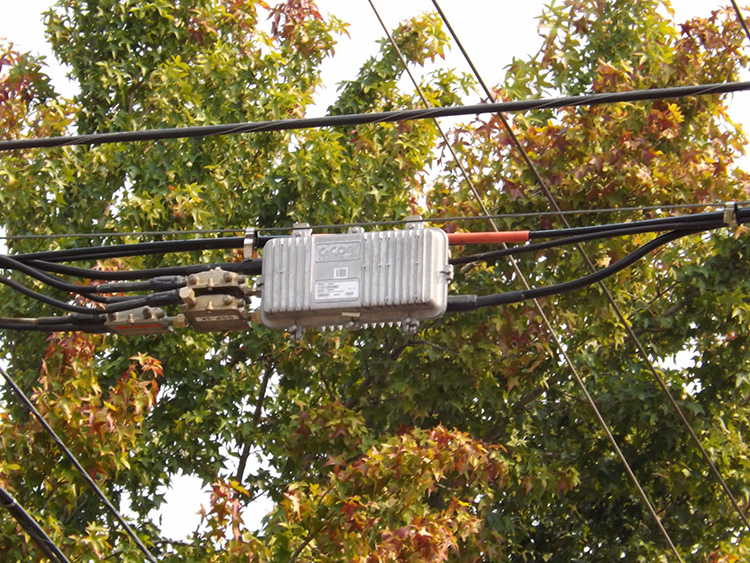 AMP - Aerial Amplifier
AMP - Aerial Amplifier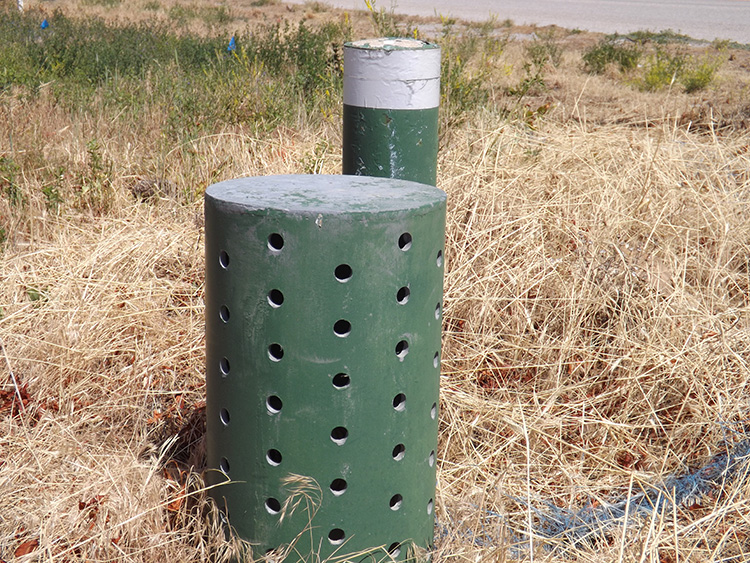 ARV - Air Release Valve
ARV - Air Release ValveB
| BC | Buried Cable |
| BFC | Buried Filled Cable: same as PIC telephone cable but with copper sheath instead of steel/aluminum. Rural Utility Services (RUS) use these. |
| BC | Buried Cable |
| BFO | Buried Fiber Optic |
| BJ | Buried Joint: Two or more utilities in the same trench – same as JT. |
| BOC | Back of Curb: the back side (towards the property) of the curb. |
| BOC | Bell Operating Company: Any one of the original 22 divisions of the Bell Telephone System, though officially all one company. These were reorganized in the 1980’s into the 7 Regional Bell Operating Companies – RBOC’s, which were truly separate companies. |
| BOW | Back of Walk: The back side (towards the property) of the sidewalk. |
| BSW | Buried Service Wire: Buried Single-Pair Phone service with a rigid outer sheath. See RSW. |
| BT | Buried Tape: Armored buried telephone cable. Shown on phone prints following the 4-letter code, such as BKTA-BT. |
C
| CADD | Computer Assisted Design and Drafting: Almost all modern computer utility prints are CADD files. |
| CATV | Cable Television: Originally CATV stood for Community Antenna Television, then Community Access Television, and eventually just Cable TV. |
| CCP | Concrete Cylinder Pipe: A type of Concrete Pipe. |
| CCTV | Closed Circuit Television: A TV system contained within a building, group of buildings, or any constricted area. CCTV is an ISP type of utility. |
| CDR | Corridor: Project corridor. |
| CEV | Controlled Environment Vault: An underground vault of electronic equipment, typically telephone DSL cabinets or fiber huts. The upper portion of a CEV can be electronically raised to allow personal access below. |
| CGA | Common Ground Alliance: A consortium of federal, state, and private groups (mostly utility owners) involved in working to lower the number of utility damages. |
| CI | Cast Iron: may also be written as CIP for Cast Iron Pipe. |
| CIC | Cable in conduit |
| CIP | Cast iron pipe |
| CL | Centerline of the road: Centerline is the official center of the road in accordance with its survey stationing. It is not necessarily halfway between the curb lines. |
| CLMC | Concrete Lined Metal Pipe: A type of Concrete Pipe. |
| CMC | Cement Mortar Coated: A type of Concrete Pipe. |
| CML | Cement Mortar Lined: A type of Concrete Pipe. |
| CMP | Corrugated Metal Pipe |
| CO | Central Office: Telephone building where a number of both phone and fiber cables come together. aka: Wire Center |
| CO | Clean Out: An access point to a sanitary sewer lateral. This is a pipe rising from the sewer lateral to the ground surface with a removable cap or plug. It is used to access the sewer lateral to free blockages. A sewer cleanout is usually located just inside the property line. |
| COAX | Coaxial Cable: Originally designed for high volume telephone communication in the 1930’s, but since the 1950’s used almost exclusively for Cable TV. |
| COND | Conduit |
| COPP | Copper: Common term for telephone cables, as is Twisted Pair Copper Cable. |
| CORE | Core Cut or Core Saw: A circular saw used to cut through concrete. After the core is cut, then a vacuum truck is used to expose the buried utility. |
| CORP STOP | Corporation Stop: The shut off valve that is placed at the connection of the service pipe to the distribution pipe. |
| CP | Cathodic Protection: A method of preventing corrosion on buried utilities by the use of sacrificial anodes. The corroding current (electrolysis) is directed to the anodes by natural methods (GACP) or by additional electric current (ICCP). |
| CP | Control Point: A survey marker, placed by a professional surveyor. |
| CPP | Corrugated Plastic Pipe |
| CRW | An obscure acronym for a Rural Service Wire. See RSW. |
| CSG | Casing: Protective covering for a pipe or cable, usually made of steel. Casings are most commonly used for gas pipes. |
| CWD | Creosote Wood Duct: Very old telephone duct run made of wood and treated with tar resin. |
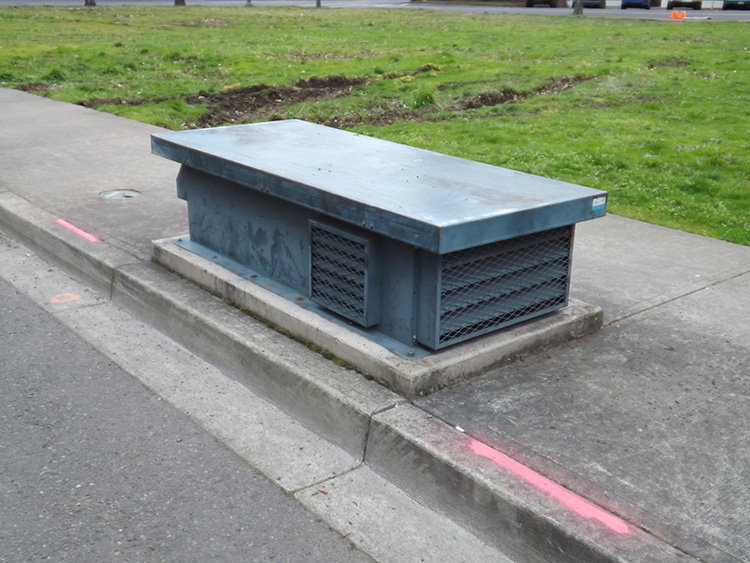 CEV - Controlled Environment Vault
CEV - Controlled Environment Vault CORE - Core Saw and Core Hole
CORE - Core Saw and Core Hole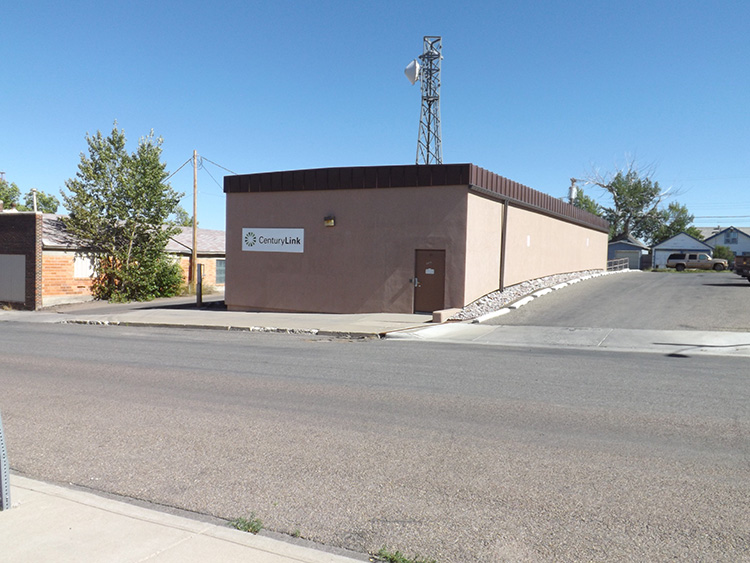 CO - Small Town Central Office
CO - Small Town Central OfficeD
| DB | Direct Buried: A cable which is not in a conduit or duct run. |
| DC | Direct Current: Current that flows in only one direction. The type of current produced by batteries. |
| DE | Dead End: The end of a utility line. |
| DI | Drain Inlet or Drop Inlet: Storm sewer. |
| DI | Ductile Iron Pipe |
| DIP | Ductile Iron Pipe. See DI. |
| DIRT | Damage Information Reporting Tool: An annual report by the Common Ground Alliance (CGA) on the number of damaged utilities in the United States each year. Often called “The DIRT Report”. |
| DOT | Department of Transportation: This can refer to the USDOT, or any of the 50 state DOTs, such as TxDOT for Texas Department of Transportation. |
| DQI | Data Quality Index |
| DSL | Digital Subscriber Line: Phone cables transmitting digital communications. |
| DSLAM | The energized cabinet used in DSL telephone systems. DSLAMs are manufactured by different companies and in various designs such as CoolPed and USAM. |
E
| EM | Electromagnetic |
| EMF | Electromagnetic Field: The radiating field created by alternating current on a conductor. Pipe and Cable Locators run on batteries, but convert the DC to AC, and therefore produce EMF on buried utilities. |
| EMS | Electronic Marker System: Trademark of the 3M Corporation. A type of RFID system. |
| EVP | Emergency Vehicle Preemption: Traffic devices used to detect emergency vehicles (First Responders) and alter the lights for them accordingly. |
| EOI | End Of Information: A common acronym used in SUE to indicate the end of a signal when using a pipe and cable locator. It is not necessarily the end of the utility line. |
F
| FDM | Frequency Division Multiplexing: The technical term for the multiplexing process used in the T-1, T-2, and T-3 phone systems. |
| FH | Fire Hydrant |
| FO | Fiber Optics: Also written as FOC for Fiber Optic Cable. |
| F/O | Fiber Optics: Same as FO. |
| FOC | Front of Curb: The front side (towards the street) of the curb. |
| FOG | Fiber Optic Ground (See OPGW) |
| FOW | Front of Walk: The front side (towards the street) of the sidewalk. |
| FTTC | Fiber to the Curb: Fiber that extends well into a neighborhood, but not all the way to the houses. |
| FTTH | Fiber to the Home: Fiber optics from the CO to the house. |
| FTTP | Fiber to the Premises: Fiber cable into a business. |
| FTTx | Any communication system which utilizes fiber optic cables for at least part of its architecture. |
G
| GACP | Galvanic Anode Cathodic Protection: A CP system which uses only sacrificial anodes made of magnesium or zinc, and which are attached to metal pipe and draw the current to ground. |
| GIS | Global Information System or Geospatial Information System: Mapping information combined from various sources. |
| GLONASS | The global navigational system operated by the Russian Federation. The American version is GPS. |
| GNSS | Global Navigation Satellite System: Any of the satellite systems used in modern mapping, land or utility. The American system is GPS. The Russian system is GLONASS. |
| GPR | Ground Penetrating radar: A nondestructive geophysical method that uses electromagnetic radiation in the microwave band of the radio spectrum to detect reflected signals from subsurface structures. |
| GPS | Global Positioning System: The GPS system is owned by the U.S. government. The Russian Federation owns and operates the GLONASS system. Combined they constitute the Global Navigational Satellite System (GNSS). |
| GRD | Ground: May imply a specific electrical ground, or simply the earth as a ground. |
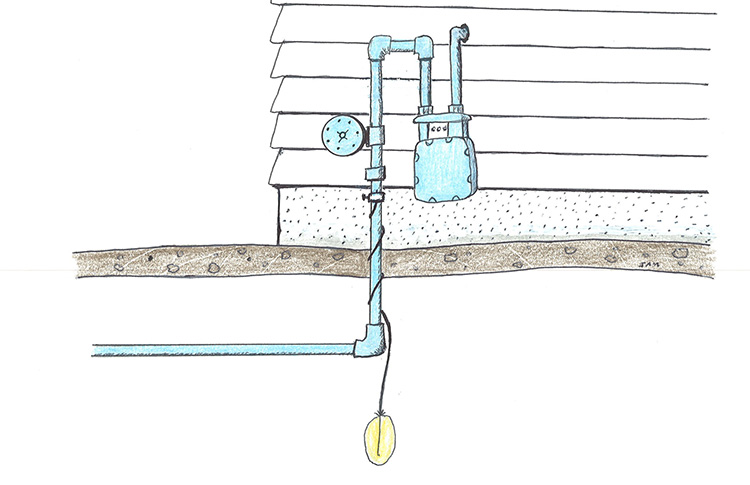 GACP - Galvanic Anode Cathodic Protection
GACP - Galvanic Anode Cathodic Protection GPR - Ground Penetrating Radar
GPR - Ground Penetrating RadarH
| HD | High Density: Usually refers to certain HD plastic pipes. |
| HDD | Horizontal Directional Drilling: (Horizontal Boring or Trenchless Technology) A method of installing underground pipes, conduits and cables along a bore path with minimal impact on surrounding area. |
| HDPE | High Density Polyethylene: Plastic Pipe |
| HFC | Hybrid Fiber Coax: A cable TV system architecture that originates at the head end as fiber optic cable, then alters to coaxial cable at a node. |
| HH | Handhole: Smaller version of a manhole. |
| HM | Hazardous Material |
| HP | High Pressure: A natural gas transmission line. |
| HP | High-Profile |
| HVL | Highly Volatile Liquid |
| Hz | Hertz: Cycles per second in electromagnetic waves. Locate frequencies are measured in hertz and kilohertz. |
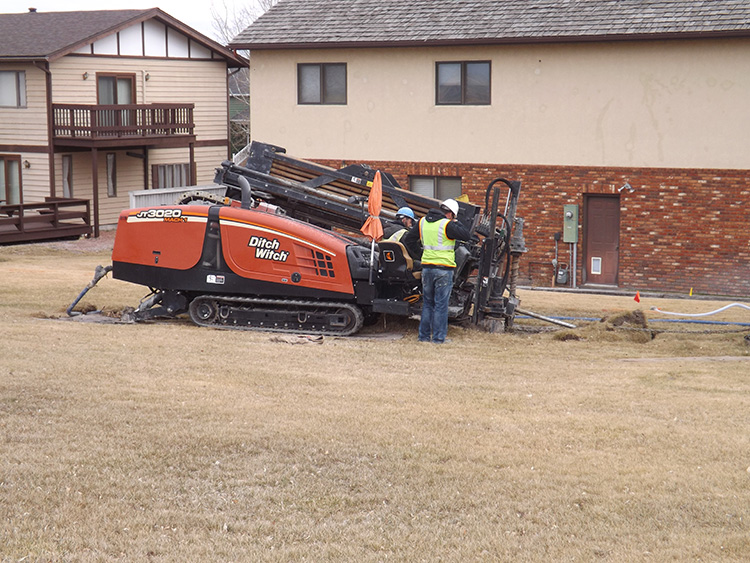 HDD - Horizontal Directional Drilling Machine
HDD - Horizontal Directional Drilling Machine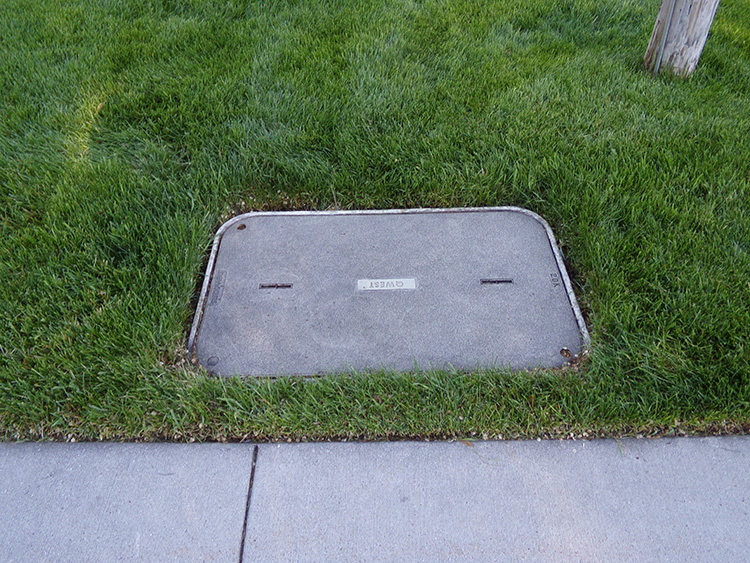 HH - Handhole
HH - HandholeI
| ICCP | Impressed Current Cathodic Protection: A CP system that applies electric current to buried metal pipes to push stray current towards a ground-well anode. |
| ID | Inside Diameter: Pipe measurement |
| INT | Intersect: A 3-way utility connection, most commonly used in reference to 3-way pipe connections. |
| INT | Interconnect: A communication line between any two or more traffic cabinets at different intersections. Interconnects are usually a 6-pair or 12-pair phone service and produce the cascading green lights when driving down the street at the proper speed limit. |
| INVERT | A measurement from a specific point at the ground surface down to the inside bottom (flow line) of a pipe. |
| ISAM | A type of DSL cabinet used by AT&T. |
| ISP | Inside Plant: Any utility line or functions inside a building. |
| ITS | Intelligent Traffic Systems: A very broad term used in reference to any of the newer traffic systems, including many that are still under development. See ATMS. |
J
| J-BOX | Junction Box: Electric feature that serves as a splice cabinet for primary power cables. Can be single phase or three phase. |
| JT | Joint Trench (Same as BJ – Buried Joint) |
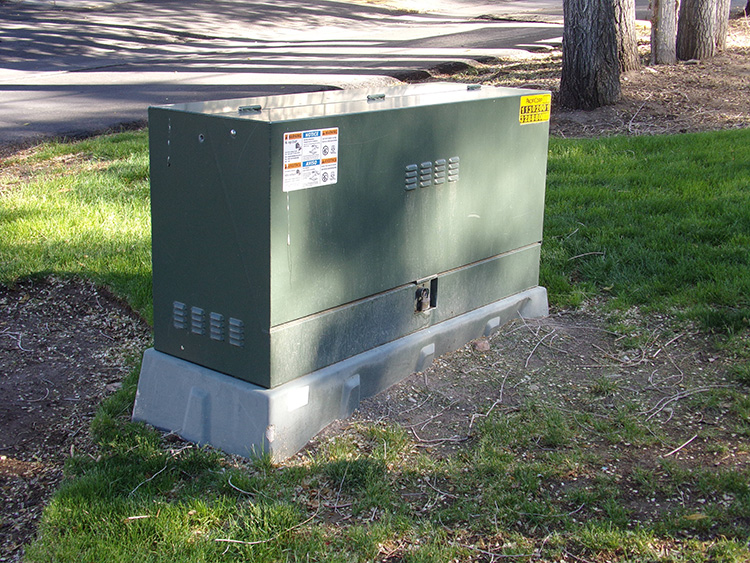 J-BOX - Junction Box
J-BOX - Junction BoxK
| kHz | Kilohertz: One thousand hertz |
L
| L-CXR | L-Carrier (L-System): A national coaxial cable system used from 1941 to 1972, but now obsolete. |
| LC | Load Coil: Telephone cable signal booster used in POTS telephone systems. May be aboveground or belowground. |
| LG | Light Guided: Early term for Fiber Optics – no longer in common use. |
| LMS | Line Management System: Fiber Cable locating system with continuous conductive contact through the sheath of the cables. Tone can be applied at the Central Office, and is of very low frequency. This allows the fiber cable to be located out over many miles using only a receiver set to the same frequency. |
| LNG | Liquefied Natural Gas |
| LPG | Liquefied Petroleum Gas |
| LT | Loose Tube: A type of fiber optic cable with a loose outer jacket. |
 LC - Load Coil
LC - Load CoilM
| mA | Milliamperes: A measurement of amperage |
| MAG | Magnetometer: An electronic instrument used for detecting the position of buried ferrous metal (iron/steel) objects such as mag nails, water valve lids, manhole lids, etc. Schonstedt is the most well know manufacturer of magnetometers. |
| Mag Nail | A specially constructed nail, short or long, with an iron core and outer steel coating. They are pre-magnetized, and easily detectable with a magnetometer. Used by surveyors for land survey and SUE technicians for test hole indicators. |
| MAIN | Main water or gas pipe: A very common reference to water or gas distribution pipes. |
| MAOP | Maximum Allowable Operation Pressure |
| MATH | Matheson pipe: Steel pipe used from about 1880 to about 1925. |
| MH | Manhole: An underground confined space entry vault, commonly at least six feet deep or more, with a small entrance opening. A “confined space” is not necessarily a “permit required confined space.” |
| MON | Monument Marker: A type of permanent survey marker, usually labeled as NAD 27 or NAD 83. The number indicates the year when the survey information was gathered: 1927 or 1983. |
| MOP | Maximum Operating Pressure |
| MP | Mechanical Protection: Armored telephone cable, shown on phone prints following the 4-letter code, such as BKTA-MP. |
| MSDS | Material Safety Data Sheet: Federally required detailed information on any possible hazardous material. |
| MSHA | Mining Safety and Hazards Administration |
| MTC | Master Telecommunications Center: A newer name for a Cable TV Headend. |
| MTD | Multiple Tile Duct: Telephone duct run (which may now also contain fiber cable) and is made of clay tile. |
| MTSO | Mobile Telephone Switching Office: The central building in a cellular telephone network in each city. |
| MUTCD | Manual on Uniform Traffic Control Devices: The book which illustrates the details of the nation standard for setting up traffic control.. |
| MUX | Multiplexer: Any cabinet for increasing the capacity of signal on a communication cable. |
 MAG - Magnetometer
MAG - Magnetometer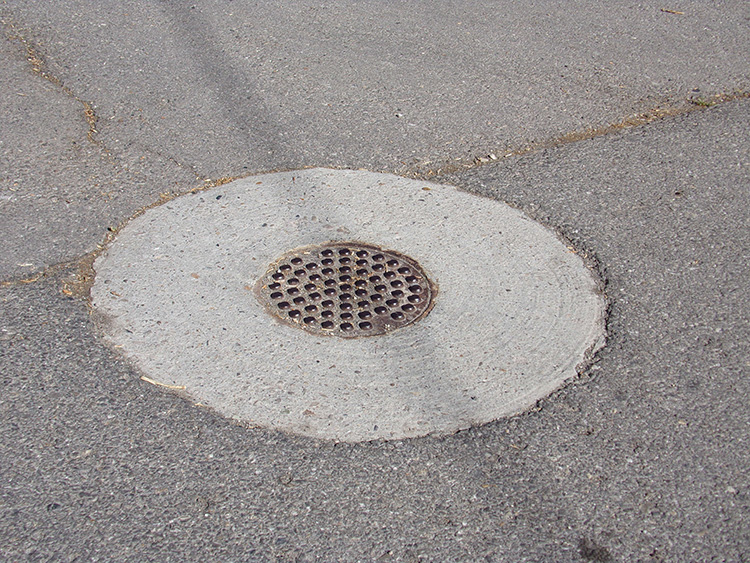 MON - Monument Marker with Protective Lid
MON - Monument Marker with Protective LidN
| NAD | North American Datum: Major North American surveys of 1927 and 1983. |
| NEC | National Electrical Code |
| NID | Network Interface Device: same as SNI |
| NIJ | Network Interface Junction: same as SNI |
| NULCA | National Utility Locating Contractors Association |
O
| OD | Outside Diameter of a pipe |
| OFCP | Optical Fiber Conductive Plenum: an armored fiber cable, but usually only placed in ISP areas. |
| OFCR | Optical Fiber Conductive Riser: an armored fiber cable, but usually only placed in ISP areas. |
| OH | Overhead Utility Cables |
| OHD | Overhead Utility Cables |
| OMNI | OMNI Marker: Brand name of one type of RFID marker. |
| OPGW | Optical Ground Wire: A cable system that consists of a fiber optics cable inside of an aluminum transmission static wire. Also known as OPG and FOG for Fiber Optic Ground. |
| OQ | Operator Qualification – A wide variety of federal safety training requirements found in the Code of Federal Regulations (CFR), including those dealing with the utilities. |
| OSHA | Occupational Safety and Hazard Administration |
| OSP | Outside Plant: Any utility line, aerial or buried, that is outside of a building. |
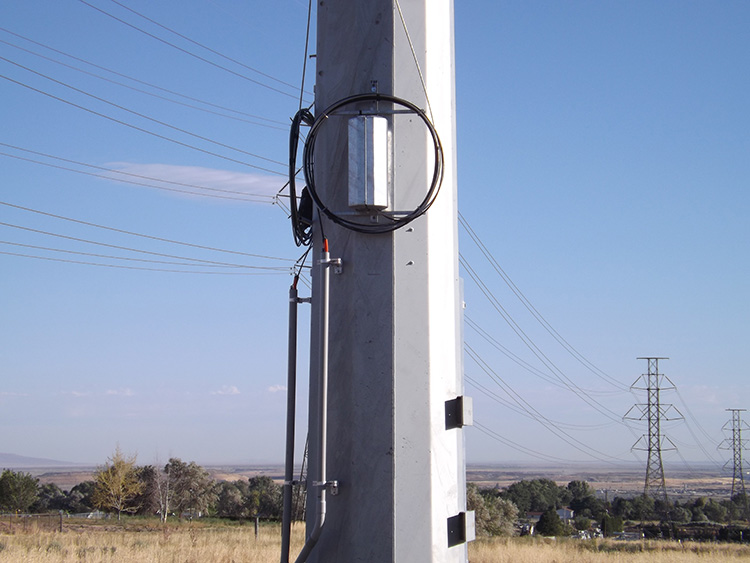 OPGW - Optical Groundwire
OPGW - Optical GroundwireP
| Passive | In utility locating/designating, a detectable signal on a buried conductive utility originating from various sources, i.e.: Not applied by the locating transmitter. |
| P&C | Pipe and Cable Locator: A two-piece electronic instrument used for locating buried utilities. The most commonly used instrument for utility tracing and mapping because it is the only instrument which can identify individual pipes and cables with high confidence when used properly. |
| PB | Polybutylene: Plastic Pipe Material |
| PCCP | Pressurized Concrete Cylindrical Pipe: A type of Concrete Pipe. |
| PCM | Pipeline Current Mapping: An electronic system of detecting coating defects on buried metal pipes. This instrument is manufactured by SPX (Radiodetection) and uses a 150 watt transmitter operating at 4 Hz. |
| PE | Polyethylene: Very common material for plastic pipe and outer cable jackets. |
| PE | Principal Engineer: A civil engineer licensed in one or more states. |
| PED | Pedestal: Any above ground utility box used as the connection (splice) point for utility cables. May be made of steel, plastic, fiberglass/resin, etc., and in various sizes. |
| PEX | Cross-linked Polyethylene: Plastic piping material used in situations of extremely hot or cold temperatures. |
| PIC | Polyethylene Insulated Cable or Plastic insulated Cable. All telephone cables produced since 1958 are PIC cables. Earlier cables are classified as either Lead Cables or Paper/Pulp Cables. |
| PILC | Paper Insulated Lead Cable: A type of electric power cable with an outer sheath of lead and inner paper insulation (much like the older phone cables). These have not been installed since the 1950’s. |
| PIV | Post Indicator Valve: A stand pipe feature which includes a visual indicator for whether or not the system is open. |
| PL | Property Line: A point at which any private property meets another private property line, or a public right of way. |
| PLS | Professional Land Surveyor: A surveyor who is professionally licensed in one or more states. In some states this profession is labeled as RPLS for Registered Professional Land Surveyor. |
| POLY | Polymer Pipe: Any type of plastic pipe, such as ABS, PE, PVC, HDPE, etc. The word “plastic” dates back at least to the early 1800’s, and only means pliable/changeable. |
| PON | Passive Optical Network: any communication system that uses fiber optic cable only, without any electric power supply being introduced in to the system between the CO or Head End and the destination point (residence or office building). |
| POTS | Plain Old Telephone Service: Any phone service that is not utilizing either T-1 or DSL, and therefore not multiplexed, is a POTS line. All telephone service was POTS until 1963. |
| PP | Polypropylene: Plastic Pipe Material |
| PP | Power Pole: Pole that has electric power, but may have phone, fiber, or coaxial cables as well. |
| PPE | Proper Protective Equipment. Usually includes a minimum of a safety vest and work boots. May include a number of other items. |
| PRV | Pressure Release Valve: Used in many pressurized water system to allow for the release of excess water pressure. Also called a “blow-off”. |
| PSI | Pounds per Square Inch (Pressure) |
| PUD | Public Utilities Department: A common term for any municipality owned utility and the city, state, or county department that operates it. |
| PVC | Polyvinyl Chloride: Plastic pipe material |
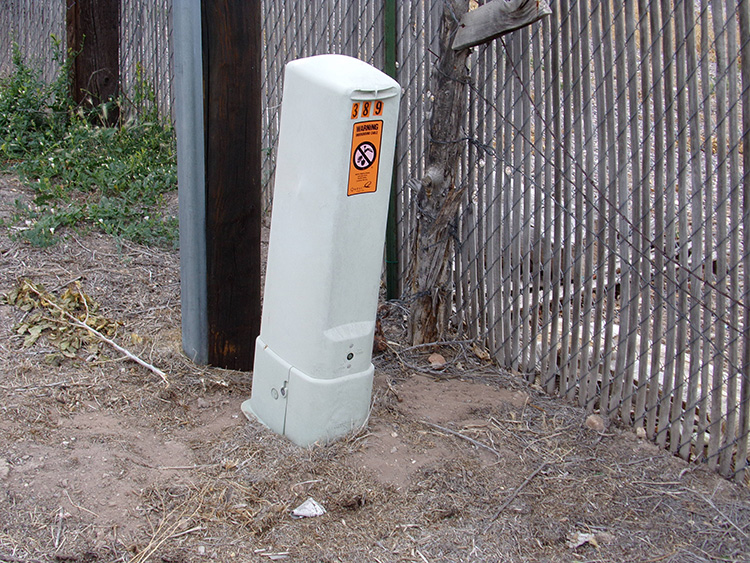 PED - Pedestal Telephone
PED - Pedestal Telephone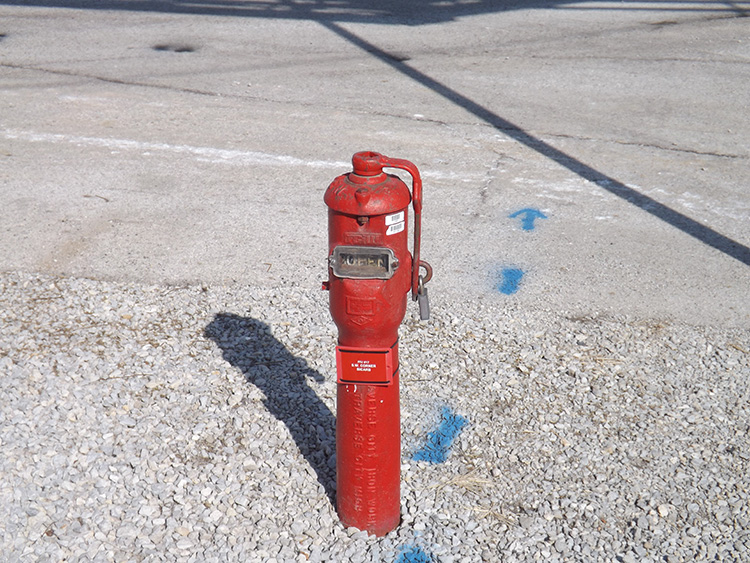 PIV - Post Indicator Valve
PIV - Post Indicator ValveQ
| QL | Quality Level: A, B, C, or D: Used in Subsurface Utility Engineering (SUE), to denote how the position of the utility line was determined. |
| QL-A | SUE Designation: A utility feature or line that can be visually seen from a vertical position, such as the end of a pipe in a manhole, or a cable exposed in a vacuum test hole. |
| QL-B | SUE Designation: A utility feature, pipe or cable that was designated electronically, such as with an pipe and cable locator, magnetometer, Ground Penetrating Radar, etc. |
| QL-C | SUE Designation: A pipe or cable whose end points can be designated accurately, but the location of the pipe or cable in between is unknown. Commonly used in reference to the storm and sanitary pipes between manholes. |
| QL-D | SUE Designation: A utility whose horizontal position is only estimated, based strictly on utility prints, hearsay, etc., but without confirmation. |
R
| RBOC | Regional Bell Operation Companies: the official term used for the seven regional phone companies that were created when the Bell System was split up in the 1980’s. |
| RCCP | Reinforced Concrete Cylinder Pipe: A type of Concrete Pipe. |
| RCP | Reinforced Concrete Pipe: Concrete pipe reinforced with iron rebar. A type of Concrete Pipe.. |
| RED | Reducer Coupling: Pipe connection between two different sized pipes. |
| REG | Regulator: Any feature used in pipe systems between two different pressure settings, including everything from service regulators at the gas meter, to large regulator stations. |
| RF | Radio Frequency: A reference to high frequency, but extremely vague. Technically Radio Frequency is everything from 30 kHz to 30,000 MHz |
| RFID | Radio Frequency Identification: Any of the buried markers placed on utility lines for later location purposes. Brand names include EMS, OMNI, and UNI-MARKER. Often called “ball markers”. |
| ROW | Right of Way (Public Right of Way): Any area that is a public owned thoroughfare, including street, sidewalk, and parkstrip areas. |
| RPTR | Repeater: Telephone cable signal clarification feature. |
| RR | Railroad |
| RSW | Rural Service Wire: A rigid jacketed, usually single-pair, telephone service wires that have been used since the 1930s. See also: BSW, ASW, and CSW. Also commonly used as a tracer wire for non-conductive fiber optic. |
| RTU | Remote Transmitter Unit: The actual on-site control box for a SCADA system. |
| RUS | Rural Utility Services: An electric power or telco co-operative partially funded by the government and found only in very rural areas. The RUS system originated with the 1934 Rural Communications Act, and the 1934 Rural Electrification Act, also in 1934. |
 RCP - Reinforced Concrete Pipe
RCP - Reinforced Concrete Pipe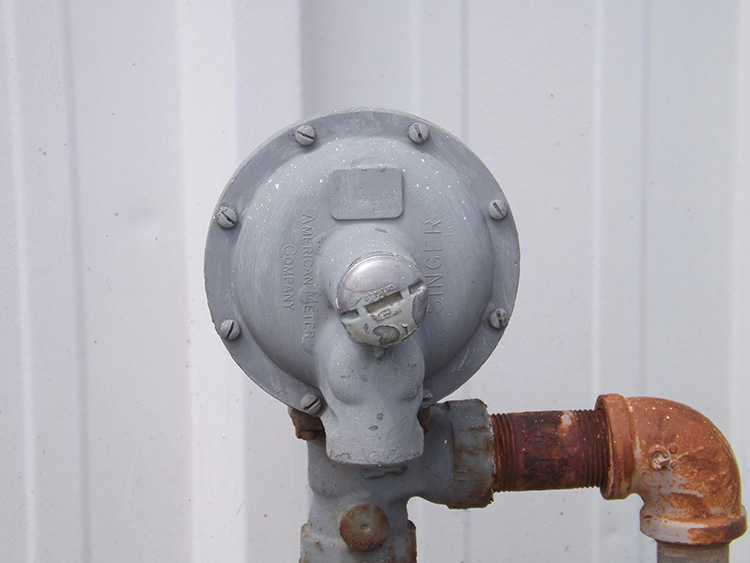 REG - Service Regulator
REG - Service Regulator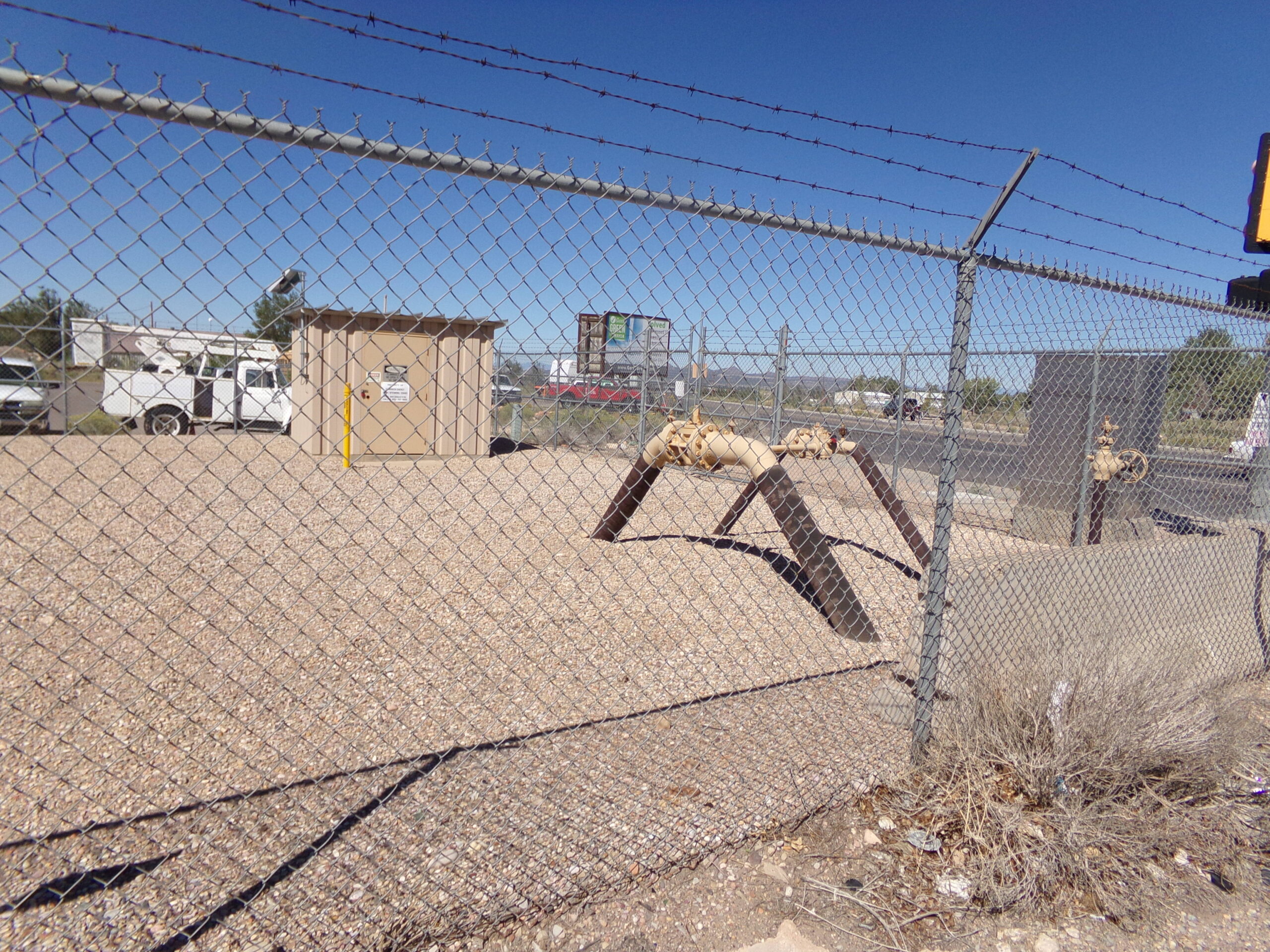 Regulator Station (City Gate)
Regulator Station (City Gate)S
| SAI | Serving Area Interface: The technical name for a Cross-Connect (X-box) in telephone systems. |
| SCADA | Supervisory Control and Data Acquisition: The overall system for remotely monitoring and controlling/switching various utility features such as water tanks, sanitary sewer lift stations, gas regulator stations, petroleum refineries, even railroad track switches. RTUs are the on-site control box. |
| SCC | Stress Corrosion Cracking |
| Scupper | A vertical hole through a bridge deck for the purpose of deck drainage. A horizontal opening in the curb or barrier is also called a scupper. |
| SD | Storm Drain |
| SL | Street Lighting |
| SLIC | Subscriber Line Interface Concentrator (SLIC Cabinet): A type of cabinet that alters Fiber Optic digital transmission to Telephone analog transmission. Fiber cable in and telephone out. |
| SNI | Single Network Interface (Protector): The small enclosure on the side of a house or building where the telephone service wire enters the building. Also known as a NIJ (Network Interface Junction) or a NID (Network Interface Device). |
| SP | Slurry System |
| SR | State Road: Any road or highway under the state’s jurisdiction, instead of the cities or towns in which it is passes through. Example: SR 35 (State Road 35). |
| STM | Steam Pipe |
| STL | Steel |
| STLCS | Steel Casing |
| SWR | Sewer: Usually meaning sanitary sewer, but can also mean storm sewer. |
| SUE | Subsurface Utility Engineering: Utility mapping project that is required to follow guidelines set by the American Society of Civil Engineers in ASCE 38-02, and the engineering firms which provide this service. |
| SUM | Subsurface Utility Mapping: Any utility mapping project that is not required to follow SUE (ASCE 38-02) guidelines. |
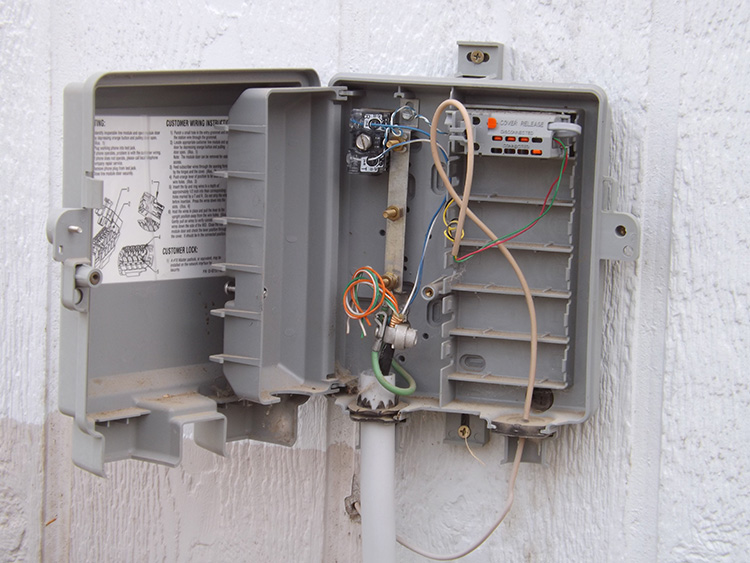 SNI - Single Network Interface
SNI - Single Network Interface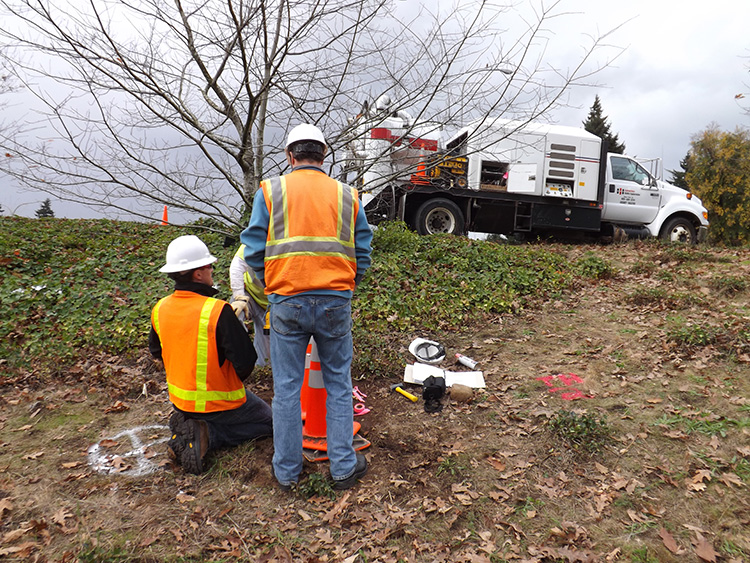 SUE - Subsurface Utility Engineering
SUE - Subsurface Utility EngineeringT
| T or TEE | Tap: A 3-way utility connection, especially a pipe distribution connection to a service or lateral. |
| T-1 | Transmission One: Telephone cable system that can carry 24 voice channels on a single phone pair service, or provide video/audio teleconferencing. The T1 system originated in 1963. Later versions are T-2 and T-3 systems. |
| TBC | Top Back of Curb: A point at the top of the concrete, at the back side (towards the property) of the curb. |
| TCP | Traffic Control Plan |
| TEL | Telephone |
| TELCO | Telephone Company: Communication company that provides telephone service on land lines to homes, typically on telephone cables, though it can be on fiber cables or coaxial. |
| TI | Telecom Infrastructure |
| TF | Transition Fitting (Transition Coupling): A pipe connector that is used between two different types of pipe material, such as between plastic and steel, or iron and AC. |
| TH | Test Hole: A hole cut through asphalt, concrete, or dirt to expose a buried utility. Test Holes require the use of a vacuum truck, and are usually no more than 12 inches in diameter. |
| TMS | Traffic Management System: same as ATMS. |
| TOC | Traffic Operations Center: Center point building of a statewide ATMS traffic system. A TOC is typically in the capital city of the State or Provence. |
| Trunk | Trunk Line: For most types of utilities “trunk line” is a common name for main/distribution line. |
| TS | Traffic Signal |
| TV | Television |
| TWRT | Thin Walled Rocket Tubing: A metal alloy military surplus pipe material used by some gas operators following World War II. Extremely rare. |
| TX | (Unknown): An antiquated metal alloy pipe material, formerly used in some natural gas systems, and possibly water systems. May also be called XT. Extremely rare. |
 TH - Test Hole in Asphalt
TH - Test Hole in AsphaltU
| UG | Underground: Commonly used on some utility prints (especially telephone) to denote a buried conduit that was empty at the time of its placement, but may now have a cable inside. Other utilities typically use UG to simply denote any buried utility line. |
| UJ | Utility Junction: An electric splice enclosure for primary cables, more commonly known as a junction box, or J-box. |
| UM | Unsoldered Mechanical: Armored telephone cables, shown on phone prints following the 4-letter code, such as BKTA-UM. |
| UNI | Uni-Marker: A type of RFID marker. |
| UNK | Unknown information |
| UPROW | Utilities and Public Right of Way |
| URD | Underground Residential Distribution: Any buried power distribution line in residential areas. |
| USAM | Universal Service Access Multiplexer: A type of telephone DSL cabinet. |
| USAM-SSE | USAM – Single Shelf Enclosure: A small DSL cabinet which can be attached to a utility pole. |
| USDOT | United States Department of Transportation |
| UST | Underground Storage Tank: This can be a gasoline tank at a gas station, an oil tank at a refinery, or an obsolete coal tank for residential heating. |
V
| VAC | Vacuum Truck: A truck specially constructed to perform test holes on buried utilities, to clean out storm drain inlets, or to dig holes for utility pole placement. Some vacuum trucks use high pressure air, some use high pressure water, and some can use both. |
| VCP | Vitrified Clay Pipe |
| VCT | Vitrified Clay Tile: Same material as VCP but used for precast telephone duct runs. |
| VEG | Vegetation Ditch: An open earth irrigation ditch. |
| VMS | Variable Message Sign: Electronic Traffic Board, which may be a portable unit, or a large permanent sign on an interstate. Also known as Reader Boards. These are an integral part of the ATMS systems. |
| VRAD | Video Ready Access Device: A type of fiber hut – fiber in and telephone out. |
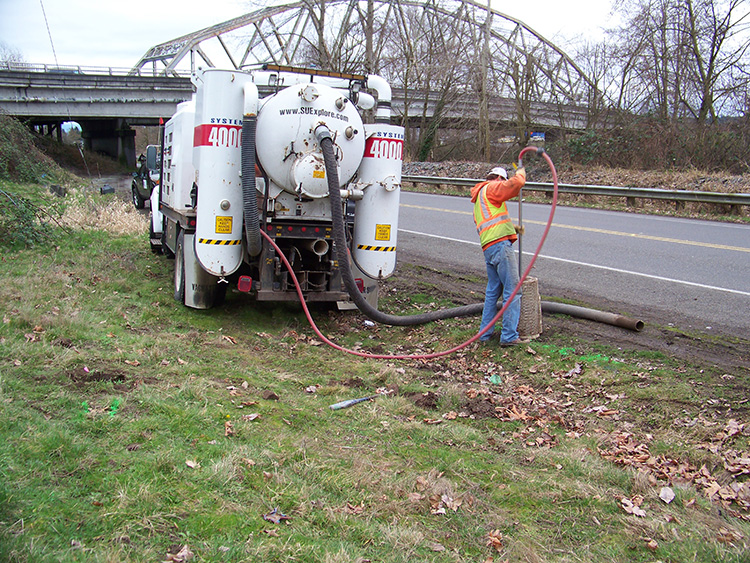 VAC - Vacuum Truck
VAC - Vacuum Truck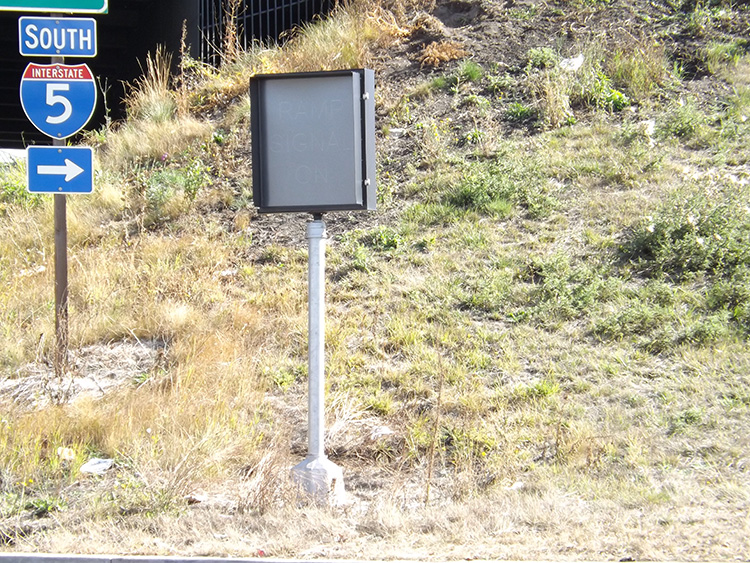 VMS - Variable Message Sign (small)
VMS - Variable Message Sign (small)W
| WD | Wood Pipe |
| WDM | Wavelength Division Multiplexing: The technical term for the more advanced multiplexing process now used with OSP fiber optic cables, but can be found on some ISP fiber as well. |
| WI | Wrought Iron: Hand pounded iron such as that performed by blacksmiths in the 19th century to make horseshoes and elaborate iron gates. The term “wrought iron” has however been used in reference to utility pipes for a very long time, but incorrectly. |
| WQI | Water Quality Inlet: A device mounted inside of storm drain inlets to isolate oil and debris, and keep it from continuing on farther downstream in the system. These have been produced by many different companies and in many different configurations. |
| WR-STL | Wrapped Steel Pipe: Steel pipe with a three-layer spiral wound tape. |
| WV | Water Valve |
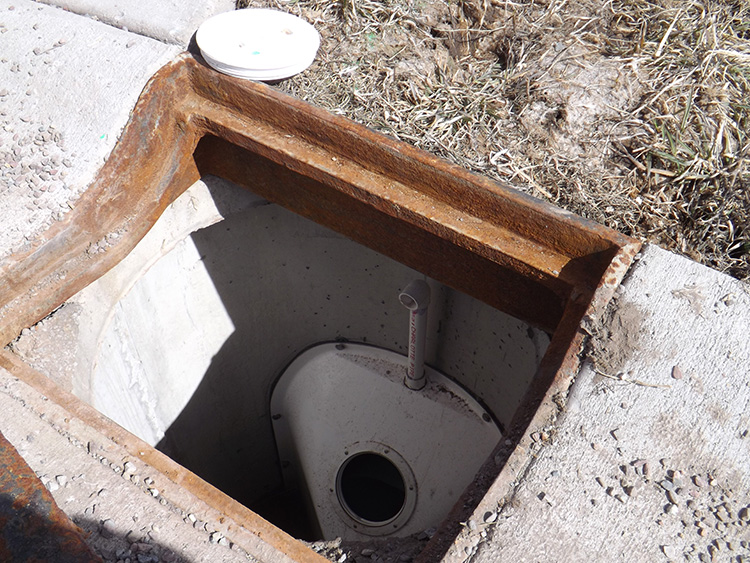 WQI - Water Quality Inlet Inside Drain Inlet
WQI - Water Quality Inlet Inside Drain InletX
| X-BOX | Cross Box or Cross-Connect: The crossover Point between feeder cables and distribution cables in telephone systems. More technically known as SAI (Service Area Interface). Cross Connects are used in all three types of phone systems: POTS, T1, and DSL. |

